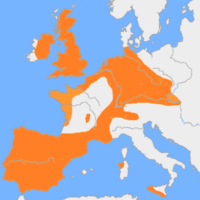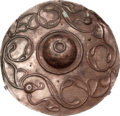Prehistoric Britain facts for kids
Prehistoric Britain was a long time in the human story of Great Britain. It ended when the Romans invaded Britain in AD 43.
Britain has been home to people for hundreds of thousands of years. The people who lived in Britain before the Romans did not have a written language. So, we learn about their history, culture, and daily life only through things that archaeologists find in the ground.
The first written record about Britain and its people came from a Greek sailor named Pytheas. He explored the coast of Britain around 325 BC. Even without writing, ancient Britons traded a lot and had cultural links with the rest of Europe from the Neolithic period onwards. They were especially known for exporting tin.
Contents
The Stone Age: Palaeolithic Period
The Palaeolithic period in Britain lasted a very long time. It started almost 750,000 years ago and ended around 10,000 years ago. During this huge period, the environment changed a lot. There were many ice ages and warmer times between them. These changes greatly affected where and how humans lived.
Early Stone Age: Lower Palaeolithic
We have found bones and flint tools near Happisburgh in Norfolk and Pakefield in Suffolk. These finds show that early humans, called Homo erectus, were in what is now Britain about 700,000 years ago. At that time, southern and eastern Britain were connected to Europe by a wide land bridge. This allowed humans to move freely. The area where the English Channel is now was a big river flowing west. It was fed by rivers that would later become the Thames and Seine.
The extreme cold of the next ice age, called the Anglian glaciation, probably made humans leave Britain completely. A warmer time followed, lasting from about 300,000 to 200,000 years ago. During this time, people had more advanced flint tools, which helped them hunt more effectively.
There is not much evidence of humans living in Britain during the next warm period, called the Ipswichian interglacial, which was between about 130,000 and 110,000 years ago.
Late Stone Age: Upper Palaeolithic
Neanderthals lived in Britain for a limited time. By 30,000 BC, we see the first signs of modern humans (Homo sapiens). The most famous discovery from this time is the burial of the Red Lady of Paviland in modern-day Wales.
Another ice age covered Britain between about 70,000 and 10,000 years ago. There was a very cold period between 22,000 and 13,000 years ago. This extreme cold might have made humans move south, out of Britain entirely. During this ice age, the land was mostly a treeless tundra. Later, the climate became warmer, perhaps reaching 17 degrees Celsius (62.6 Fahrenheit) in summer. This warmer weather helped birch trees, shrubs, and grasses grow.
The main food species hunted were the Wild Horse (Equus ferus) and Red Deer (Cervus elaphus). But other mammals, from hares to mammoths, were also hunted. By 10,500 years ago, the climate became cooler and drier. Animal populations seemed to decrease, even though woodlands grew. In the very late Upper Palaeolithic, tools were made from smaller flints. Tools made from bone and antler became less common. However, many more sites from this period are known and are spread out more widely, including open-air sites like Hengistbury Head.
The Middle Stone Age: Mesolithic Period
Around 10,000 years ago, the ice age finally ended. Temperatures rose, probably to levels similar to today. Forests grew much larger. By 8,500 years ago, the rising sea levels from melting glaciers cut Britain off from continental Europe for the last time. The warmer climate changed the cold Arctic environment into one with pine, birch, and alder forests.
From Hunting to Farming: Mesolithic-Neolithic Transition
Farming of both crops and domestic animals started in Britain around 4,500 BC. This happened partly because people needed more reliable ways to get food.
The New Stone Age: Neolithic Period
People used to think that the Neolithic period in Britain began with many new people arriving from Europe. But modern archaeology now suggests that farming, along with pottery and settled living, was actually adopted by the people already living there. These native people were related to the newly farming Neolithic people across the water. We know there were links with Europe because archaeologists have found axes made from unusual stones like jadeite.
Scientists have studied the mitochondrial DNA of people in Europe today. This shows that over 80% of them are descended from European hunter-gatherers through their mothers. Less than 20% are descended from Neolithic farmers from the Middle East through their mothers. In 1997, DNA was studied from a tooth of a Mesolithic man. His remains were found in Gough's Cave at Cheddar Gorge. His mitochondrial DNA was a type found in 11% of modern European people.
These discoveries make us question the old idea that new groups of people completely replaced earlier ones. In any case, the Neolithic Revolution, as it's called, brought a more settled way of life. It eventually led to societies being divided into different groups, like farmers, artisans (skilled craftspeople), and leaders.
The building of the first earthwork sites in Britain began during the early Neolithic (around 4400 BC - 3300 BC). These were long barrows, which were long mounds used for burying many people together.
The Middle Neolithic (around 3300 BC - 2900 BC) saw the creation of cursus monuments. These were long, narrow earthworks often built near earlier barrows. The first stone circles and individual burials also appeared.
Later, new enclosures called henges were built. Also, stone rows and the famous sites of Stonehenge and Silbury Hill reached their most impressive stages. Large-scale flint mining, like at Cissbury and Grimes Graves, also began.
The Bronze Age
Around 2,700 BC, a new culture arrived in Britain, often called the Beaker culture. Their special pottery, called Beaker pottery, appeared during the Mount Pleasant Phase (2,700 BC - 2,000 BC). Flat axes and burying the dead by inhumation (burying the whole body) also became common. The huge stone phases of Stonehenge were built during this time.
Britain had large amounts of tin in areas like Cornwall and Devon in southwest England. So, tin mining began. By about 1,600 BC, the southwest of Britain had a big trade boom. British tin was sent all across Europe.
The Beaker people were also very good at making beautiful things from gold. Examples of these have been found in the graves of wealthy people from the Wessex culture in southern Britain.
The Iron Age
Around 750 BC, techniques for working with iron reached Britain from southern Europe. Iron was stronger and more common than bronze. Its arrival marks the start of the Iron Age. Iron working changed many parts of life, especially agriculture. Iron-tipped ploughs could turn up land much faster and deeper than older wooden or bronze ones. Iron axes could clear forest land much more easily for farming.
Around 900 BC, British society changed again. By 500 BC, the Celtic culture had spread across most of the British Isles. The Celts were very skilled craftspeople. They made beautifully patterned gold jewellery and weapons from bronze and iron.
Iron Age Britons lived in organized tribal groups, led by a chieftain. As more people lived in Britain, fights often broke out between different tribes. This led to the building of hill forts. The first of these forts had been built around 1,500 BC. Britain also traded hunting dogs, animal skins, and slaves.
Late Pre-Roman Iron Age
In the last few centuries before the Roman invasion, refugees from Gaul (which is modern-day France and Belgium) arrived. These people were known as the Belgae. They were displaced as the Roman Empire grew.
From around 175 BC, they settled in areas like Kent, Hertfordshire, and Essex. They brought with them pottery-making skills that were much more advanced than anything made before. The Belgae had some Roman influences. They were responsible for creating the first settlements large enough to be called towns.
Around 100 BC, iron bars started to be used as currency. Later, coins were developed, based on types used in Europe.
As the Roman Empire expanded north, Rome began to take an interest in Britain. You can learn more about this period in Roman Britain.
Images for kids
-
Boxgrove handaxes at the British Museum
-
Robin Hood Cave Horse, from Creswell Crags
-
Wandsworth Shield, in the Insular version of La Tène style, 2nd century BC
See also
 In Spanish: Gran Bretaña prehistórica para niños
In Spanish: Gran Bretaña prehistórica para niños







